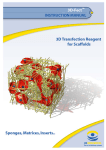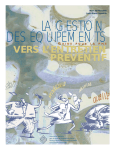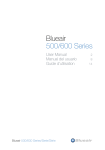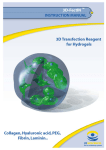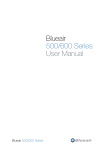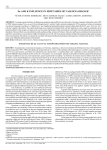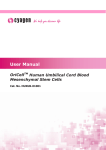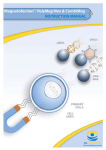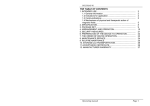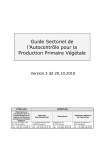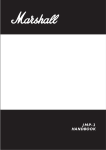Download User Manual
Transcript
DreamFect™ Stem Transfection Reagent INSTRUCTION MANUAL Mesenchymal Stem Cells, Adipose-derived Stem Cells, Amniotic Fluid Stem cells… www.bocascientific.com DreamFect™ Stem Instruction Manual DreamFect™ Stem is an original, simple and efficient method especially developed to transfect multipotent stem cells with high transfection efficiency and superior transgene expression level. List of DreamFect™ Stem kits Volume (µL) Catalog Number Description ST30500 DreamFect™ Stem 500 125-250 ST31000 DreamFect™ Stem 1 000 250-500 Size (number of transfection / µg of DNA) USA and Canada contact: Boca Scientific Inc. 950 Peninsula Corporate Circle Suite 1025 Boca Raton, FL 33487 Tel: 561-995-5017 Fax: 561-995-5018 [email protected] www.bocascientific.com OZ Biosciences – DreamFect™ Stem – Instruction Manual -1- Table of contents 1. Technology 1.1. Description 1.2. Kit contents 2. Applications 2.1. Application Areas 2.2. Cell Types 3. Protocols 3.1. General Considerations 3.2. Rapid Protocol – Adherent cells 3.3. Suspension cells protocol 3.4. Optimization Protocol 4. Appendix 4.1. Quality control 4.2. Troubleshooting 5. Related Products 6. Purchaser Notifications 2-3 2 2 3 3 3 3-6 3 3 4 5 7 7 7 8 9 1. Technology 1.1. Description Congratulations on your purchase of the DreamFect™ Stem transfection reagent! DreamFect™ Stem is the newest transfection reagent based on the Tee-Technology (“Triggered Endosomal Escape”) which combines and exploits the properties of cationic lipids and polymers to achieve an extremely efficient DNA delivery into stem cells. Because stem cells behavior, physiology and properties are quite distinctive to other cells, OZ Biosciences has developed a specific transfection reagent for stem cells. DreamFect™ Stem is a powerful reagent with improved cytoplasmic release and better biodegradability dedicated to multipotent stem cells. This transfection reagent allows DNA delivery in a variety of stem cells. In addition, multipotent stem cells transfection with DreamFect™ Stem is achieved using low doses of DNA. Consequently, stem cells keep their undifferentiated stage and their capacities to differentiate. DreamFect™ Stem main advantages in comparison to standard procedures: 1. High transfection efficiency for multipotent Stem Cells 2. Minimized toxicity due to reagent biodegradability and low DNA amount required 3. Does not affect phenotype and differentiation potential 4. Serum Compatible 5. Simple, Ready-to-use and rapid (no specific buffer) 1.2 Kit Contents OZ Biosciences offers two sizes of DreamFect™ Stem reagent. 1 tube containing 500 µL of DreamFect™ Stem good for 125 to 250 transfections with 1 µg of DNA 1 tube containing 1 mL of DreamFect™ Stem good for 250 to 500 transfections with 1 µg of DNA Stability and Storage Storage: Upon reception and for long-term use, store the reagent at 4°C. DreamFect™ Stem kits are very stable for at least one year at the recommended storage temperature. Shipping condition: Room Temperature. OZ Biosciences – DreamFect™ Stem – Instruction Manual -2- 2. Applications 2.1. Application Areas DreamFect™ Stem reagent has been specifically developed for very efficient transfection of plasmid DNA into multipotent stem cells. This transfection reagent is serum compatible, biodegradable and can be used with your defined complete medium. This product is very stable, ready-to-use and intended for research purpose only. 2.2. Cell Types DreamFect™ Stem reagent is suitable for a variety of stem cells such as adult stem cells (Mesenchymal Stem Cells, Adipose-derived Stem Cells), Amniotic Fluid Stem Cells or leukemic stem-like cells (KG1a). An updated list of transfected cells is available on OZ Biosciences website: www.ozbiosciences.com. You can also submit your data to [email protected], so we can update this list and give you all the support you need. 3. Protocols 3.1. General Considerations The instructions given below represent sample protocols that were applied successfully with several types of stem cells. Optimal conditions may vary depending on nucleic acid, cell types, size of cell culture dishes and presence or absence of serum. Therefore, the amounts and ratio of the individual components (DNA and DreamFect™ Stem) may have to be adjusted to achieve best results since each cell type has a particular optimal transfection reagent/nucleic acids ratio. As a result, we suggest you to optimize the various transfection parameters as described in section 3.4. The following recommendations can be used as guidelines to quickly obtain very good transfection and high transgene expression level. As starting point, we recommend to use 3 µL of DreamFect™ Stem / 1 µg of DNA (for optimal conditions suggested range 2 to 4 µL of DreamFect™ Stem / 1 µg of DNA). DreamFect™ Stem can be used in the presence or in the absence of serum. You can use your complete culture medium, except during the preparation of the DreamFect™ Stem / DNA complexes. Cells should be healthy and present a small number of passages. The presence of contaminants (Mycoplasm, fungi) will considerably affect the transfection efficiency. Nucleic acids should be as pure as possible. Endotoxins level must be very low since it can interfere with transfection efficiency. In the same way, transfection grade plasmid DNA (high degree of supercoiled forms) are recommended to achieve the highest expression. We also suggest avoiding long incubation time of the DNA solution in buffer or serum free medium before the addition of DreamFect™ Stem to circumvent any degradation or surface adsoption. Antibiotics. The exclusion of antibiotics from the media during transfection has been reported to enhance gene expression levels. We did not observe a significant effect of the presence or absence of antibiotics with the DreamFect™ Stem reagent and this effect is cell type dependent and usually small. A protocol used for other transfection reagents should not be employed for DreamFect™ Stem and inversely. Each transfection reagent has its own molecular structure, biophysical properties and concentration, which have an important influence on its biological activity. OZ Biosciences – DreamFect™ Stem – Instruction Manual -3- 3.2. Rapid Protocol - Adherent cells - Seed the cells the day prior transfection. The cells should be at 50-70% confluent at the time of transfection. - Use cells with a low number of passages. - DNA and DreamFect™ Stem solutions should be at room temperature and be gently vortexed prior to use. Use 3 µL of DreamFect™ Stem per µg of DNA. We suggest beginning with this ratio and then optimize it, if required, by following section 3.4. Table 1: Suggested amounts of DNA and reagent depending on your cell culture dishes DreamFect Stem Cell culture dish DNA quantity Dilution volume Transfection volume Volume 96 well plate 0.125 µg 0.375 µL 2 x 25 200 µL 24 well plate 0.5 µg 1.5 µL 2 x 50 500 µL 12 well plate 1 µg 3 µL 2 x 50 1 mL 6 well plate 2 µg 6 µL 2 x 100 2 mL 60 mm dish 3 µg 9 µL 2 x 150 4 mL 100 mm dish 6 µg 18 µL 2 x 250 8 mL T-75 flask 10 µg 30 µL 2 x 350 10 mL 1. DNA solution. Dilute 0.125 µg to 10 µg of DNA in 25 µL to 350 µL (see Table 1) of culture medium WITHOUT serum and antibiotics (ideally DMEM, -MEM, opti-MEM or PBS). 2. DreamFect™ Stem solution. Dilute 0.375 µL to 30 µL of DreamFect™ Stem (see Table 1) in culture medium WITHOUT serum and antibiotics (ideally DMEM, -MEM, opti-MEM or PBS). 3. Add the DNA solution to the DreamFect™ Stem solution, mix gently by vortexing slowly or pipetting up and down 4-5 times. Incubate the mixture for 20 min at room temperature. The diluted solutions should be combined within 5 minutes. 4. Add the mixture dropwise to the cells growing in complete medium and homogenize by gently rocking the plate side to side to ensure a uniform distribution of the mixture. 5. Incubate the cells at 37°C in CO2 incubator under standard conditions. 6. Optional but highly suggested: Cell medium could be changed with fresh complete medium after 4 to 6h incubation. 7. Evaluate your transgene expression after 24 to 72 h following transfection. OZ Biosciences – DreamFect™ Stem – Instruction Manual -4- 3.3. Suspension cells Protocol - The day prior transfection split the cell, in order to have them in an exponential phase of growing. On the day of transfection, DNA and DreamFect™ Stem solutions should be at room temperature and be gently vortexed prior to use. Use 3 µL of DreamFect™ Stem per µg of DNA. Table2: Transfection conditions suggested for suspension cells Cell culture dish 96 well plate 24 well plate 6 well plate 60 mm dish Suspension cells number 0.5 – 1 x 105 2 – 4 x 105 10 – 15 x 105 5 x 106 DNA quantity 0.25 µg 1 µg 3 µg 6 µg DreamFect Stem Volume 0.75 µL 3 µL 9 µL 18 µL Dilution volume 2 x 25 2 x 50 2 x 50 2 x 100 Transfection volume 100 µL 250 µL 1 mL 2.5 mL 1. DNA solution. Dilute 0.25 µg to 6 µg of DNA in 25 µL to 100 µL (see Table 2) of culture medium WITHOUT serum and antibiotics (ideally DMEM, -MEM, opti-MEM or PBS). 2. DreamFect™ Stem solution. Dilute 0.75 µL to 18 µL of DreamFect™ Stem in culture medium (see Table 2) WITHOUT serum and antibiotics (ideally DMEM, -MEM, opti-MEM or PBS). 3. Add the DNA solution to the DreamFect™ Stem solution, mix gently by vortexing slowly or pipetting up and down for 4-5 times. Incubate the mixture for 20 min at room temperature. The diluted solutions should be combined within 5 minutes. 4. During complexes incubation, prepare your cells preferentially in serum-free medium. Seed the cells in half of the volume currently use (see Table 2). 5. Add the mixture dropwise to the cells. 6. Incubate the cells at 37°C in CO2 incubator under standard conditions for 4h. 7. Add culture medium containing 20% serum (same volume as transfection volume). 8. Incubate your cells at 37°C under standard conditions until evaluation of your transgene expression (24 to 72 h following transfection). Important Observations: A. Note that transfection of cells in suspension are optimal when performed in the absence of serum. However, transfection can also be achieved directly in the presence of serum. B. From our experiences, the key feature is to promote as much as you can the contact between the cells and the transfection complexes. Consequently, here are a few additional propositions: Option 1, concentrate your cells: When the complexes are forming prepare your cells. Spin down the cells, resuspend them at 10 × 106 cells / mL in medium (serum free) and transfer the appropriate cell number to your well according to Table 2. Thereafter, mix the complexes with the cells, incubate 15 minutes and complete the culture medium as indicated in Table 2. Option 2, promote contact by centrifugation: Centrifuge the plate after having mixed the cells with the transfection complexes for 2-3 minutes at around 1000-1200 rpm. 3.4. Optimization Protocol Although high transfection efficiencies can be achieved with the rapid protocol in a various types of stem cells, some optimization may be needed in order to obtain the maximum efficiency for particular stem cells or cell culture conditions. For best results, we recommend optimization of the transfection protocol for each combination of plasmid and stem cell type used in order to get the best out of DreamFect™ Stem. OZ Biosciences – DreamFect™ Stem – Instruction Manual -5- Several parameters can be optimized: Ratio of DreamFect™ Stem to nucleic acid Dose of nucleic acid used Cell type and cell density Culture medium composition (+/- serum) and reagent / nucleic acid complex medium Incubation time We recommend that you optimize one parameter at a time while keeping the other parameters (cell number, incubation time etc.) constant. The two most critical variables are the ratio of DreamFect™ Stem reagent to DNA and the quantity of DNA. 1) DreamFect™ Stem / DNA ratio: This is an important optimization parameter. DreamFect™ Stem has to be used in slight excess compare to DNA but the optimal ratio will depend on the cell line and the vessel used. It is particularly true for 96 well plates because of adsorption processes. For optimization, first maintain a fixed quantity of DNA (according to the size of your culture dish or cell number) and then vary the amount of DreamFect™ Stem reagent over the suggested range in the Table 3. You can test ratios from 1 to 6 µl of DreamFect™ Stem reagent per 1 µg DNA. Table 3: Suggested range of DreamFect™ Stem for optimization. Tissue Culture DNA Quantity DreamFect Stem Dish Volume (µL) (g) 96 well 24 well 12 well 6 well 60 mm dish 90 - 100 mm dish T-75 flask 0.1 0.5 1 2 5 10 15 0.1 – 0.6 0.5 – 3 1–6 2 – 12 5 – 30 10 – 60 15 – 90 2) Quantity of DNA: To achieve optimal transfection efficiency, the amount of DNA used can be increased. However a high amount of the complexes can result in over-expression or lysis of the cells. These effects vary with the number of cells so, it is important to always keep the number of cells and the incubation time constant during your optimization procedure. Thus, after optimization of the DreamFect™ Stem / DNA ratio, proceed to adjust the best amount of DNA required by maintaining a fixed ratio of DreamFect™ Stem reagent to DNA, and vary the DNA quantity over the suggested range (Table 4). Table 4: Suggested range of DNA amounts for optimization Tissue Culture Dish Transfection Volume DNA Quantity (g) 96 well 0.1 – 0.5 200 µL 24 well 0.25 – 2 500 µL 12 well 1–4 1 mL 6 well 2 – 10 2 mL 60 mm dish 5 – 30 4 mL T-75 flask 15 – 90 10 mL Thereafter, culture medium compositions, cell number, incubation times can also be optimized. 3) DreamFect™ Stem / Nucleic acid complex medium: Several tests demonstrated that the use of PBS to prepare the DNA and DreamFect™ Stem solutions instead of serum- and antibiotic-free medium leads to more reproducible transfections and in some cases higher efficiency, particularly with lower volumes of transfection reagent. PBS composition: 137mM NaCl, 2.7mM KCl, 1.5mM KH2PO4 and 6.5mM Na2HPO4 x 2 H2O; pH7.4. 4) Cell number: The cell proliferating rate is also a critical parameter in particular for stem cells and the optimal confluency has to be adjusted according to the cells used. Thus, the next step is to use the optimized ratio and DNA amount obtained previously and vary the cell number to be assayed. Note. The addition of the transfection complex directly to freshly seeded cells can result in a considerable increase of transfection efficiency. OZ Biosciences – DreamFect™ Stem – Instruction Manual -6- 5) Effect of serum /Transfection volume: Almost all stem cell types transfected with DreamFect™ Stem showed superior results if serum is present during the transfection. Some stem cells may behave differently and transfection efficiency can be increased without serum or under reduced serum condition. Remember that presence of serum during complex formation is strictly prohibited, as the serum will inhibit their formation. Transfection efficiency is attained when the initial 3-4 hours of incubation is done. Consequently, the cells may be kept in serum-free or reduced serum conditions during the first 4 hours of transfection. If you use serum-free medium, replace it by a culture medium containing serum or just add serum to the wells according to your standard culture condition after this period. To increase the efficiency of transfection you can reduce the transfection volume. 6) Incubation time: The optimal time range between transfection and assay for gene activity varies with cell type, promoter activity, expression product, etc. Transfection efficiency can be monitored after 24 - 96 hours by analyzing the gene product. Reporter genes such as GFP, secreted alkaline phosphatase or luciferase can be used to quantitatively measure gene expression. OZ Biosciences team has developed a detailed protocol for optimization and also cell specific optimal transfection procedures. Thus, do not hesitate to contact our technical service at [email protected] to request these specific protocols. 4. Appendix Our dedicated and specialized technical support team will be pleased to answer any of your requests and to help you with your experiments at [email protected]. In addition, do not hesitate to visit our website www.ozbiosciences.com and the FAQ section. 4.1 Quality Controls To assure the performance of each lot of DreamFect™ Stem produced, we qualify each component using rigorous standards. The following in vitro assays are conducted to qualify the function, quality and activity of each kit component. Specification Standard Quality Controls Purity Silica Gel TLC assays. Every compound shall have a single spot. Sterility Thioglycolate assay. Absence of fungal and bacterial contamination shall be obtained for 7 days. Biological Activity Transfection efficacies on MSC cells. Every lot shall have an acceptance specification of > 80% of the activity of the reference lot. 4.2. Troubleshooting Problems Low transfection efficiency Comments and Suggestions 1- DreamFect™ Stem / nucleic acid ratio. Optimize the reagent / nucleic acid ratio by using a fixed amount of DNA (µg) and vary the amount of DreamFect™ Stem from 2 times less up to three times more than the suggested amount detailed in the Table 3 and 4. 2- DNA amount. Use different quantity of DNA with the recommended or optimized (above) transfection reagent / DNA ratio. 3- Cell density. A non-optimal cell density at the time of transfection can lead to insufficient uptake. The optimal confluency should range from 50 to 70% (true confluency, corresponding to 90% visual confluency) but most favorable cell density may vary according to the cell type; preferably mid-log growth phase. OZ Biosciences – DreamFect™ Stem – Instruction Manual -7- Low transfection efficiency 4- DNA quality. Nucleic acids should be as pure as possible. Free of contaminants (proteins, phenol, ethanol etc.) and endotoxins levels must be very low since they interfere with transfection efficiencies. Employ nuclease-free materials. 5- Type of promoter. Ensure that DNA promoter can be recognized by the cells to be transfected. Another cells or viral-driven reporter gene expression can be used as a control. 6- Cell condition. 1) Cells should have the less passage as possible (< P5). 2) Cells that have been in culture for a long time (> 8 weeks) may become resistant to transfection. 3) Cells should be healthy and assay during their exponential growing phase. 4) The presence of contaminants (mycoplasma, fungi) alters considerably the transfection efficiency. 7- Medium used for preparing DNA / transfection reagent complexes. It is critical that serum-free medium or buffer (HBS, PBS) are used during the preparation of the complexes. Avoid any direct contact of pure DreamFect™ Stem and pure nucleic acid solution with the plastic surface. 8- Cell culture medium composition. 1) For some cells, transfection efficiency can be increased without serum or under reduced serum condition. Thus, transfect these cells in serum-free medium during the first 4h of incubation. 2) The presence of antibiotics might affect cell health and transfection efficiency. 9- Incubation time and transfection volume. 1) The optimal time range between transfection and assay varies with cells, promoter, expression product, etc. The transfection efficiency can be monitored after 24 – 96h by analyzing the gene product. Several reporter genes can be used to quantitatively monitored gene expression kinetics. 2) To increase transfection efficiency, transfection volume suggested can be reduced for the first 24 hours. 10- Old transfection reagent / DNA complexes. The transfection reagent / DNA complexes must be freshly prepared every time. Complexes prepared and stored for longer than 1 hour can be aggregated. 11- Transgene detection assay. Ensure that your post-transfection assay is properly set up and includes a positive control. 12- Transfection reagent temperature. Reagents should have an ambient temperature and be vortexed prior to use. Cellular toxicity 1- Unhealthy cells. 1) Check cells for contamination, 2) Use new batch of cells, 3) Ensure culture medium condition (pH, type of medium used, contamination etc), 4) Cells are too confluent or cell density is too low, 5) Verify equipments and materials 2- Transgene product is toxic. Use suitable controls such as cells alone, transfection reagent alone or mock transfection with a DNA control. 3- DNA quality - Presence of contaminants. Ensure that nucleic acid is pure, contaminantfree and endotoxin-free. Use high quality nucleic acids as impurities can lead to cell death. 4- Concentration of transfection reagent / nucleic acid too high. Decrease the amount of nucleic acid / reagent complexes added to the cells by lowering the nucleic acid amount or the transfection reagent concentration. Complexes aggregation can cause some toxicity; prepare them freshly and adjust the ratio as outlined previously. 5- Incubation time. Reduce the incubation time of complexes with the cells by replacing the transfection medium by fresh medium after 4h to 24h. Our dedicated and specialized technical support group will be pleased to answer any of your requests and to help you with your transfection experiments: [email protected]. In addition, do not hesitate to visit our website www.ozbiosciences.com and the FAQ section. OZ Biosciences – DreamFect™ Stem – Instruction Manual -8- 5. Related Products Description MAGNETOFECTION TECHNOLOGY Super Magnetic Plate (standard size for all cell culture support) Mega Magnetic plate (mega size to hold 4 culture dishes at one time) Transfection reagents: PolyMag Neo (for all nucleic acids) Magnetofectamine™ (for all nucleic acids) NeuroMag (dedicated for neurons) SilenceMag (for siRNA application) Viral Transduction enhancers: ViroMag (to optimize viral transduction) / AdenoMag (for Adeno viruses) ViroMag R/L (specific for retrovirus and Lentivirus) AdenoMag (for adenovirus and aav) In vivo Targeted Delivery In vivo PolyMag (for all nucleic acids) In vivo DogtorMag (for all nucleic acids) In vivo ViroMag (for all viral vectors) LIPOFECTION TECHNOLOGY (LIPID-BASED) Lullaby (siRNA transfection reagent) DreamFect Gold (Transfection reagent for all types of nucleic acids) VeroFect (for Vero cells) FlyFectin (for Insect cells) I-MICST TECHNOLOGY Viro-MICST (to transduce directly on magnetic cell purification columns) Capture and Concentration of Virus Mag4C (to capture, concentrate and conserve viruses) 3D TRANSFECTION TECHNOLOGY 3Dfect (for scaffolds culture) 3DfectIN (for hydrogels culture) RECOMBINANT PROTEIN PRODUCTION HYPE-5 Transfection Kit (for High Yield Protein Expression) PROTEIN DELIVERY SYSTEMS Ab-DeliverIN (delivery reagent for antibodies) Pro-DeliverIN (delivery reagent for protein in vivo and in vitro) PLASMIDS PVECTOZ pVectOZ-LacZ pVectOZ-SEAP ASSAY KITS Bradford – Protein Assay Kit MTT cell proliferation kit β-Galactosidase assay kits (CPRG/ONPG) BIOCHEMICALS D-Luciferin, K+ and Na+ X-Gal powder 1g / G-418, Sulfate Do not hesitate to contact us for all complementary information and remember to visit our website in order to stay inform on our last breakthrough technologies and updated on our complete product list. [email protected] / www.ozbiosciences.com OZ Biosciences – DreamFect™ Stem – Instruction Manual -9- Purchaser Notification Limited License for DreamFect™ Stem The purchase of DreamFect™ Stem Reagents grants the purchaser a non-transferable, non-exclusive license to use the kit and/or its separate and included components (as listed in section 1, Kit Contents). This reagent is intended for in-house research only by the buyer. Such use is limited to the transfection and transduction of nucleic acids and virus as described in the product manual. In addition, research only use means that this kit and all of its contents are excluded, without limitation, from resale, repackaging, or use for the making or selling of any commercial product or service without the written approval of OZ Biosciences. Separate licenses are available from OZ Biosciences for the express purpose of non-research use or applications of DreamFect™ Stem Reagents. To inquire about such licenses, or to obtain authorization to transfer or use the enclosed material, contact the Director of Business Development at OZ Biosciences. Buyers may end this License at any time by returning all DreamFect™ Stem Reagents material and documentation to OZ Biosciences, or by destroying DreamFect™ Stem Reagents components. Purchasers are advised to contact OZ Biosciences with the notification that DreamFect™ Stem Reagents kit is being returned in order to be reimbursed and/or to definitely terminate a license for internal research use only granted through the purchase of the kit(s). This document covers entirely the terms of DreamFect™ Stem Reagents research only license, and does not grant any other express or implied license. The laws of the French Government shall govern the interpretation and enforcement of the terms of this License. Product Use Limitations for DreamFect™ Stem DreamFect™ Stem Reagents and all of its components are developed, designed, intended, and sold for research use only. They are not to be used for human diagnostic or included/used in any drug intended for human use. All care and attention should be exercised in the use of the kit components by following proper research laboratory practices. For more information, or for any comments on the terms and conditions of this License, please contact: OZ Biosciences Director of Business Development Parc Scientifique et Technologique de Luminy 163, avenue de Luminy, zone entreprise, case 922 13288 Marseille Cedex 9, France Tel: +33 (0)4.86.94.85.16 Fax: +33 (0)4. 86.94.85.15 E-mail: [email protected] OZ Biosciences – DreamFect™ Stem – Instruction Manual - 10 -











